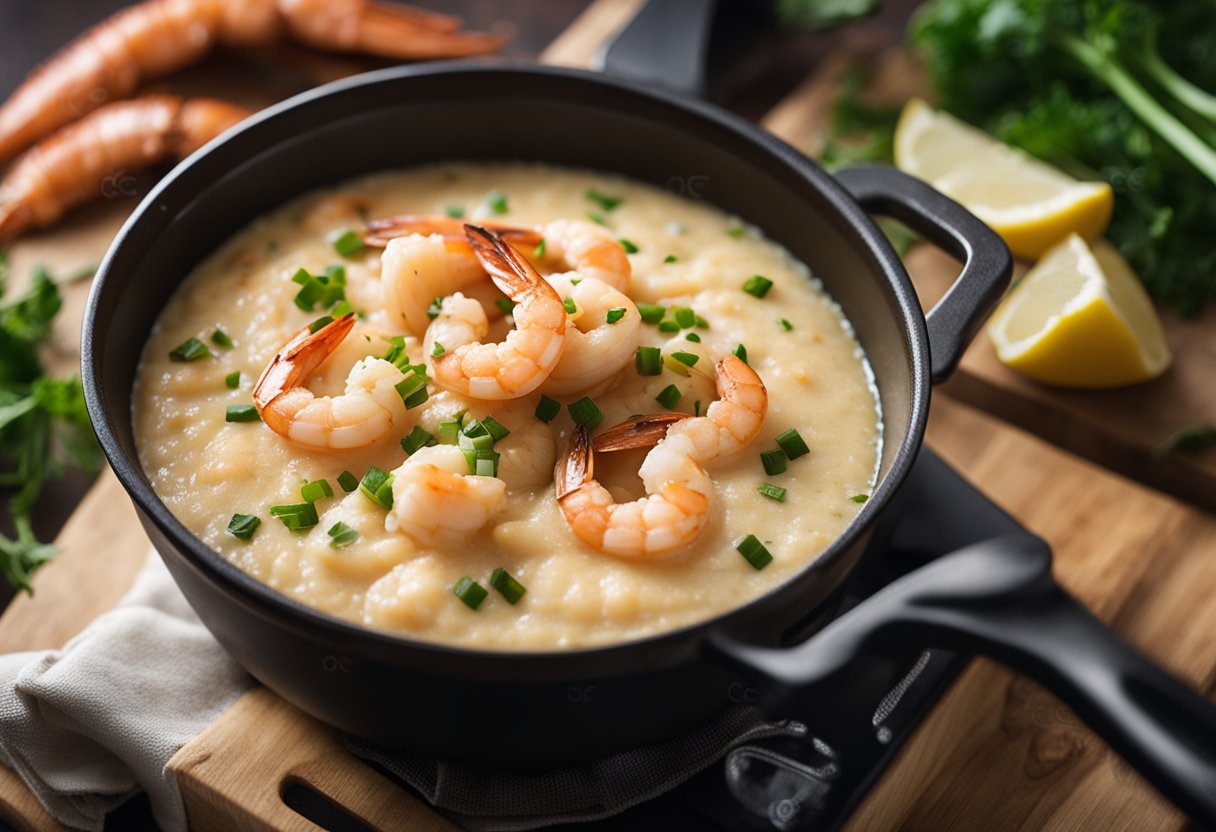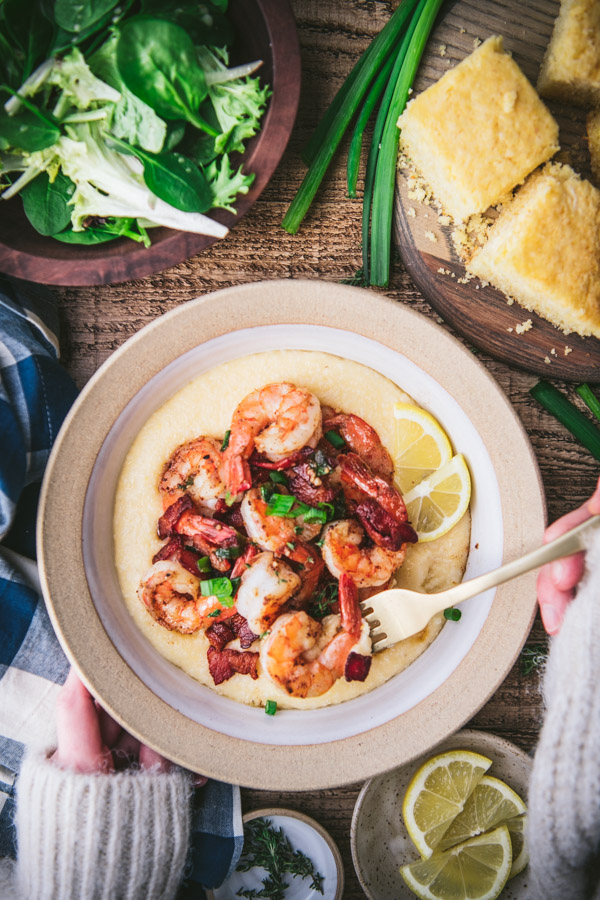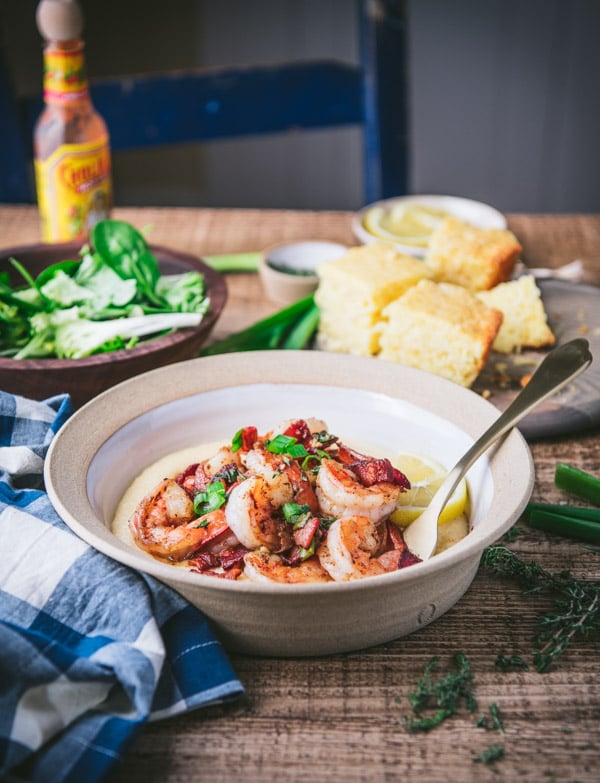This easy Southern shrimp and grits recipe can be used for brunch on a slow Sunday morning or as a quick dinner during the week. The down-home comfort food tastes great and only takes 30 minutes to make. For a tasty meal, pair the Cajun shrimp and cheese grits with a simple salad, collard greens, cornbread, or biscuits.
Shrimp and grits is a quintessential Southern dish that combines tender shrimp with creamy cheesy grits for an explosion of flavors. Like many seafood dishes shrimp and grits are best when freshly made. However, with a little finesse, leftover shrimp and grits can be revived into a meal that tastes like it was just prepared.
Follow this complete walkthrough on properly reheating shrimp and grits to achieve the ideal texture and taste. With a few simple tricks, you can enjoy this iconic dish throughout the week without compromising on quality.
Why Proper Reheating is Crucial
Shrimp can dry out and rubberize quickly when reheated carelessly. The delicate seafood requires gentle, moist heat to restore its texture. Grits also tend to thicken as they cool losing their creamy consistency. Simply tossing shrimp and grits in the microwave leads to overcooked shrimp and dry, clumpy grits.
By reheating each element carefully and combining them just before serving, you can mimick freshly-made shrimp and grits. It requires a little more effort than careless reheating, but the payoff is incredible. With the right techniques, leftovers can taste as amazing as the original version.
Step 1 – Reheat the Grits
Grits require indirect, gentle heat and extra moisture to regain their soft, creamy texture.
-
Place leftover grits in a saucepan with a splash of milk, broth or water. The extra fluid prevents drying.
-
Warm over medium-low heat, stirring frequently.
-
As grits heat, continue adding splashes of liquid as needed to reach the desired creamy consistency.
-
Stir often from the bottom to prevent sticking or scorching.
-
Once heated through, remove grits from heat and cover to retain warmth while reheating shrimp.
Proper stovetop reheating gently brings grits back to their original texture without drying them out.
Step 2 – Reheat the Shrimp
Shrimp can go from succulent to rubbery in seconds if care isn’t taken when reheating. Use these tips:
-
Place leftover shrimp in a skillet or saucepan with a small amount of butter or oil.
-
Heat over medium-low heat to gently warm shrimp without overcooking.
-
Stir frequently to ensure even heating.
-
Once warmed through, remove shrimp from heat. They will continue cooking off heat.
-
Avoid using the microwave as it can make shrimp tough. Gentle stovetop heat is best.
With a bit of finesse, leftover shrimp can be revived to a tender, juicy state.
Step 3 – Combine and Serve
For the best texture and flavor, only combine the shrimp and grits when ready to eat.
-
Scoop grits into bowls.
-
Top with desired amount of shrimp.
-
Garnish with chopped parsley, scallions, hot sauce, or other favorites.
-
Enjoy your shrimp and grits renewed to original freshness!
Letting them mingle too long will cause the shrimp to overcook and become rubbery. Keeping them separate until plating preserves quality.
Expert Tips for Reheating Perfection
-
When reheating grits, stir in extra cheese for added richness.
-
Avoid overcrowding shrimp in the pan when reheating – cook in batches if needed.
-
Undercook shrimp slightly when initially preparing the dish to allow for reheating.
-
Sprinkle reheated shrimp with a squeeze of lemon to enhance freshness.
-
Reheat any sauce or gravy for the grits separately to retain consistency.
-
Refrain from reheating more than 3-4 days after initial preparation.
With a little finesse and TLC, shrimp and grits can taste fantastic even as leftovers. Follow these steps and tips to enjoy the full flavors without compromise. Proper reheating brings this Southern favorite back to life.
Common Questions about Reheating Shrimp and Grits
Can you reheat grits and shrimp together?
It’s best to reheat them separately. Shrimp overcooks easily and combining them too early will cause the shrimp to become rubbery. Keep them separate until ready to serve.
Is it OK to reheat shrimp in the microwave?
Microwaves often overcook shrimp, so it’s better to use the stovetop. The gentle, indirect heat prevents them from becoming tough.
How do you add moisture back to leftover grits?
Stir in splashes of milk, broth, half-and-half, cheese, or water while reheating grits to restore creaminess. Add a little at a time until reaching the perfect consistency.
How can you tell if reheated shrimp are overcooked?
Shrimp overcooked from reheating will be tough and rubbery. Properly reheated shrimp will be tender, with a slightly translucent look when gently pressed.
What’s the best way to reheat cheese grits?
Place in a saucepan with milk or half-and-half, stirring often. For extra richness, sprinkle in some additional shredded cheese at the end.
How long do leftover shrimp and grits last in the fridge?
Store leftovers in airtight containers. Properly refrigerated, they will last 3-4 days before quality starts declining. Reheat only what you will consume.
Is it OK to reheat the sauce for shrimp and grits?
Yes, any leftover sauce or gravy can be reheated gently in a saucepan, stirring frequently. Add a splash of milk or water if the sauce becomes too thick.
Can I prep shrimp and grits in advance for a party?
Yes, you can make them 1-2 days ahead. Reheat the components gently and separately on the stovetop before combining to serve.
What’s the best reheating method for a hurry?
For quick reheating, use the microwave on Medium power in 30 second bursts for the grits, stirring between. Reheat shrimp for even less time to prevent overcooking.
Leftover shrimp and grits can be just as amazing as the fresh original when you use the proper reheating techniques. With a little TLC, you can enjoy the full flavors and textures throughout the week. Follow this guide for reheated shrimp and grits that taste like they were just prepared.

tips for the best shrimp and grits recipe
- That being said, any size shrimp will work in this recipe. We like extra large or jumbo shrimp (16–20 count per pound). For a “fancy” touch, leave the tail on the peeled shrimp.
- How long it takes to cook all together will depend on how big your shrimp are. When the shrimp turn pink and cloudy, they’re done. Watch out not to cook the shrimp too long, or they will get tough and rubbery.
- Add chopped fresh herbs like parsley, thyme, or rosemary or thin slices of green onion to the dish for a colorful and flavorful finish.
- It takes 438 calories to make this shrimp and grits recipe, and it’s full of protein, making it a hearty, satisfying meal. The dish is not low-carb or Keto-friendly. There is no gluten in the ingredients in this recipe. However, you should check your ingredients to make sure they are not contaminated with gluten.

Preparation and Storage Tips
- This dish is best when served fresh. The grits and shrimp can both be reheated separately right before serving, but the texture of both isn’t great when they’re made ahead of time and then reheated.
- Leftovers will keep in the refrigerator for 2-3 days. It’s best to keep the grits and shrimp in separate containers because they will need different amounts of time to heat up properly.
- Put cooked grits in one container and cooked shrimp in a different container that won’t let air in. You can keep them in the freezer for up to two months.
- How to Reheat: Once more, I don’t like making shrimp and grits ahead of time. But if you don’t want to throw away the extras, you can mix cold grits with a little water or milk. Put it back in the microwave for one minute at a time and stir it often until it warms up and gets creamy again. For about one more minute, until hot, add the shrimp to the bowl when it’s almost done.
- You can purchase instant grits, quick grits, or stone-ground grits. This recipe calls for quick grits, but any kind will work. Just change the cooking time to fit your needs.
- After adding the shrimp to the pan, add a splash of heavy cream. This will make the shrimp and grits creamy. Allow the cream to bubble and thicken slightly before serving.
- There are many good melting cheeses that you can use instead of sharp cheddar. You could use American cheese (like Velveeta), Pepper Jack cheese, Colby cheese, Colby-Jack cheese, mozzarella cheese, or white cheddar cheese.
- Add a little red wine vinegar instead of the lemon juice.
- You can use finely diced yellow onion instead of green onion. It may need a few more minutes in the pan to soften, so put it in before the rest of the ingredients.
- Add about 2 cups of chopped red bell peppers, mushrooms, or celery to the pan with the garlic and green onions. Sauté until the vegetables are soft, then add the shrimp as directed.
- Add ½ package of thinly sliced kielbasa or andouille sausage to the pan with the garlic and green onions. Cook until the sausage is browned, then add the shrimp as directed.

